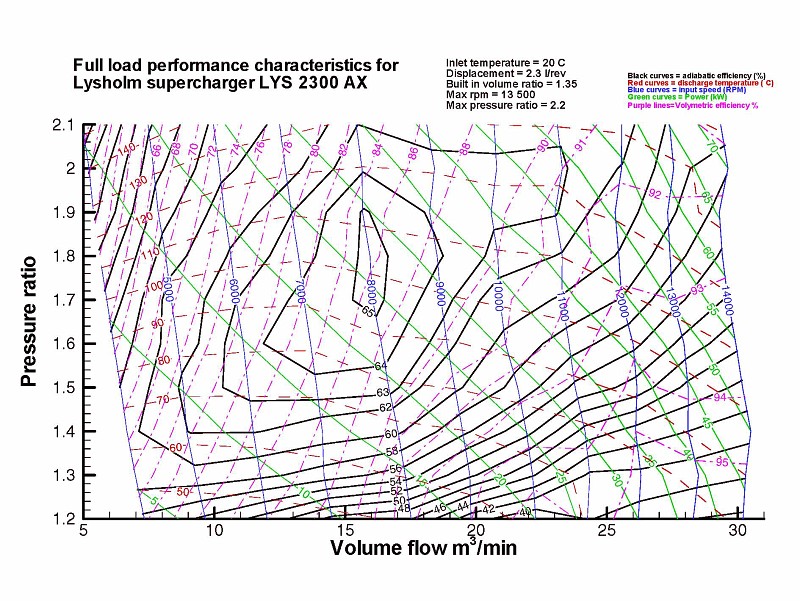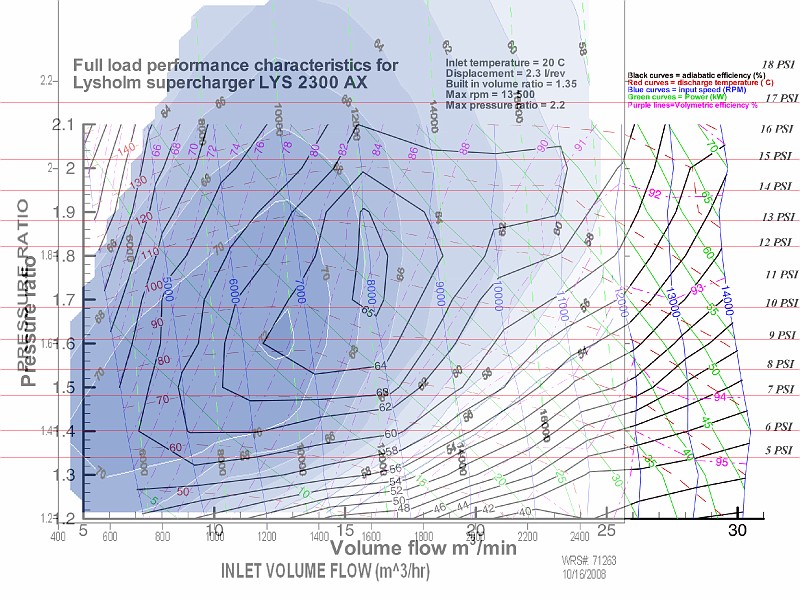Here is a good read from a mustang website that will give insite to several of you on how to read and compare effeciency maps for Superchargers.
Let's have a smack-down. Using some charts.
In the left corner, a Magnuson TVS blower featuring Eaton's TVS2300 roots type blower, 4 lobes, 160 degree twist. Yes, ladies and gentlemen, these are the same screws used in the Roush TVS R2300, the Edelbrock E-Force, and the new Corvette ZR1.

In the right corner, a Lysholm twin-screw. 2.3 liters of displacement
(Oh noes, you can't possibly do an apples to apples comparison using blowers of the same displacement! OH noes!!! Kenne Bell, can you hear me?)

You don't have to be an engineer to see what these charts mean...the bottom line is the left axis is boost. It is expressed in pressure ratio. We know that sea-level standard pressure on a standard day is 14.7 PSI (If you really care, that is also at 59 degrees F / 15C at 1013.2 millibars of pressure and 29.92 inches of mercury).
The formula for converting boost in PSI to P/R is (14.7 + PSI)/14.7 - P/R
So at 18 PSI your pressure ratio should be (14.7 + 18) / 14.7 = 2.22
Zero boost would be a pressure ratio of 1.0 or atmospheric pressure (14.7).
No need to understand that since I am about to add a boost chart on the right axis for you...
The bottom axis is the amount of airflow through the supercharger.
See the "rings" and the "islands"? These are supercharger efficiency maps. The little "islands" are showing how efficient the supercharger is at a given pressure ratio and flow rate. The smallest little island is the supercharger's "sweet spot" where it is most efficient.
You can compare two different superchargers by comparing these efficiency maps.
I have accomplished an overlay of the two charts, and I added boost to the right column for your reference based again on sea level pressure at 14.7:
The result is educational.

What does it mean to me? It means the TVS is more efficient design until we exceed about 16 PSI. Why? Let's continue...
Let's take the very best the 2.3 Lysholm twin screw can do...and that is its "efficiency island" which is at a BLOWER RPM of 8,000 and 10-13 PSI of boost - it is at 65%.
The TVS, at the EXACT same location has an efficiency of 67-68%, and the TVS is spinning at 12,000 blower RPM.
Advantage TVS by 2-3%.
What if we go the the TVS sweet spot? That is at 9,500 TVS blower RPM and 9 PSI of boost, and is 72%. How is the twin-screw doing at that point? It is spinning at 6,600 RPM, making the exact same boost, but its efficiency is only 64% - so an
8% difference favoring the TVS.
Where does the twin-screw have an advantage? Look at 16 PSI at 2200 M3/MIN...the TVS efficiency is at 61%, and the twin-screw is at 62%...so above 16PSI the advantage shifts to the twin-screw. At 18 PSI @ 2400 M3/MIN the TVS is 58% efficient - and the twin-screw is at 62% (actually off the twin-screw chart, but we can interpolate).
I have read that interpreting this is kind of like looking at peak horsepower and torque. What is more important is not so much peak values but looking at "the area under the curve" on a dyno chart - and the TVS appears to have superior efficiency throughout more of the chart until we get above that 16 PSI level. Guess what a stock pullied Roush P-51 makes? You guessed it, 15-16 PSI - right at the top of the TVS designed sweet spot.
I, like many others, initially read this article...
Mustang GT500 Supercharger Tests - 5.0 Mustang & Super Fords Magazine
...and determined that the twin screws were superior to the TVS. I think my determination was wrong, and that is why I am posting this.
That article is not a fair comparison for one major reason: You are comparing a 2.3 liter TVS to a 2.8 liter twin-screw. Now if I owned a GT500, what would I install? Probably a KB 2.8 it simply makes more power and does so more efficiently because it is BIGGER.
But if we level the playing field (as I have done here in my comparison) or, if Eaton were to build a 2.8 liter TVS to go against KB's 2.8 liter twin-screw I
personally think the TVS will prove to be more efficient design until you get into boost exceeding 16 PSI (as I have shown above)...but even respecting the twin-screws advantage at higher boost levels above 16 PSI, taken as a whole I think the TVS will still have more "area under the curve" if you will and be overall superior to the twin-screw design.
For a street car, I think the TVS
design is the cat's jammies.
Don't forget that these are static efficiency maps. Meaning they are derived from the blowers operating at steady state. You also want to look at them to see how you transition from one state to the next. Meaning, low end (rpm) to mid power settings will help describe how driveable a particular blower might be. You should be looking at the gradients on the map as well as the overall picture.
You can actually eyeball the chart(s) and see what the blower would do as you "drive"...keeping in mind that as you "step on it" you move to the right and up simultaneously on the chart...remember the bottom axis is increased airflow through the blower and the vertical axis moving upward is increased boost. As you let off the gas, the boost drops down as the bypass valve opens up and the airflow through the blower decreases. The fact that the sweet area of the rings on the TVS chart is lower and farther left tells me the TVS is probably more "streetable, since on the street we don't spend a lot of time at max RPM / max airflow / max boost...rather we are constantly transitioning from idle to intermediate throttle settings, keeping the TVS in its optimum range. At the drag strip, the Twin-Screw is probably the hot ticket since we are running at max boost / max airflow and full throttle.
Another plus of a roots type blower is the fact that a roots is an air pump, whereas a screw is a compressor...so at idle, cruising, or deceleration on a roots, our bypass valve is open and the blower is cooling nicely with very little drag on the engine. On a twin-screw, at cruise or deceleration, by the very nature of the screw design it is still compressing and heating the air - even if you don't want boost. Of course at high boost pressures, the twin-screw is more efficient, as I stated above.